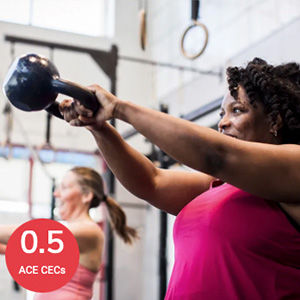
Designing an effective resistance-training program requires blending science with engaging, positive exercise experiences. To create workouts that produce the desired adaptations, health and exercise professionals must consider numerous variables, including client goals, preferences, exercise selection, session duration, training experience and equipment availability. Additional key factors include sets, reps, rest intervals, intensity (load), session format (such as traditional, circuit, supersets or high-intensity resistance training) and repetition tempo (time under tension).
Of these factors and variables, repetition tempo is one of the most frequently overlooked, even though it plays a crucial role in program design. This article explores how repetition tempo can be used to create individualized, evidence-based resistance-training programs.
What is Repetition Tempo?
Repetition tempo refers to the speed at which each phase of a movement is performed. A commonly recommended tempo is six seconds per repetition, a cadence often associated with weight-stack (selectorized) machine training. Generally, the concentric (lifting) phase should take one to three seconds, while the eccentric (lowering) phase should last two to four seconds. However, other controlled tempos, ranging from two to eight seconds per repetition, can be equally effective.
Tempo is typically represented by a four-digit sequence, indicating the duration of each phase of a movement: eccentric (lowering), isometric/transition, concentric (lifting) and isometric/transition. For example, a tempo of 4/0/2/0 suggests a four-second eccentric phase, no pause at the transition, a two-second concentric phase, and no pause before starting the next repetition. In a bench press, this would mean lowering the bar for four seconds, immediately pressing it up for two seconds, and beginning the next rep without pausing. Understanding and applying tempo variations allows you to fine-tune resistance-training programs for specific client goals.
Repetition tempo can be either intentional or unintentional. As described earlier, intentional tempos are deliberately controlled to achieve specific training adaptations. However, tempo can also change unintentionally due to factors like fatigue. For example, when lifting a heavy load, muscle fatigue may slow the movement, increasing the duration of each repetition. Conversely, using a lighter load allows for greater control, enabling a deliberate adjustment of tempo without fatigue impacting movement velocity.
Training tempo plays a key role in resistance training, influencing time under tension, the number of repetitions completed and the maximum load lifted. By understanding and manipulating tempo, you can tailor your programs to optimize strength, endurance, hypertrophy or power development.
Determining whether to use a faster or slower tempo is a crucial but sometimes challenging decision. Fortunately, a recent review of the literature has shed some light on current research on this topic. Researchers revealed the following key points as part of their review:
- For muscular hypertrophy, the most effective adaptations occur when fast concentric movements are combined with slower eccentric movements.
- While slower tempos require lighter loads, pairing them with increased time under tension provides sufficient stimulus for both strength and hypertrophy gains.
- Faster concentric speeds are believed to optimize neural adaptations and strength development. However, extending the eccentric phase can enhance hypertrophy and strength without negatively impacting neural adaptations.
In other words, a variety of repetition tempos that adjust the speed of both the eccentric and concentric phases of an exercise can bring about different muscular-training adaptations and therefore should be considered when determining how to help a client pursue their specific goals. Next, let’s take a closer look at additional research on this topic to further explore how repetition tempo plays a role in exercise program design.
Current Research on Movement Tempo
A meta-analysis examining the effects of intentionally slow concentric resistance exercise on strength adaptations found that increasing time under tension by slowing repetition tempo did not enhance strength gains. In fact, the analysis revealed that traditional or faster movement speeds led to significantly greater strength improvements. Researchers suggest that slower tempos may hinder power development by reducing both velocity and force. Additionally, when concentric movements are intentionally slowed, strength adaptations tend to be less pronounced.
A 2025 study examined how eccentric (lowering) phase tempo in squats influences strength, hypertrophy and the contractile properties of the quadriceps femoris. Eighteen participants were randomly assigned to two groups, both training with the same relative load and number of sets until muscle failure or loss of proper form. One group performed a one-second eccentric phase, while the other used a four-second eccentric phase, with both groups maintaining a one-second concentric phase.
The study found that eccentric tempo impacts both time under tension and training volume. The slower tempo group experienced greater time under tension, whereas the fast eccentric group completed more repetitions. Ultimately, the findings suggest that slower eccentric tempos may be more effective for hypertrophy in specific quadriceps muscles.
Yet another narrative review examining strategies for optimizing resistance training to maximize muscle hypertrophy highlighted repetition tempo as a key factor. The review reinforced that muscular adaptations can occur across a range of movement tempos, typically between two and eight seconds per repetition. As a health and exercise professional, it is your role to determine how to distribute that time across the different phases of each movement.
While an ideal repetition tempo for specific goals has yet to be definitively established, the review emphasizes the importance of performing the eccentric phase in a controlled manner. This ensures that the muscles—not just gravitational forces—are actively managing the descent of the load.
Exercise Program Design
Before setting the repetition tempo in your client’s training program, first identify the goal behind the change. Consider the tempo they are currently using and track any modifications to assess their impact. In other words, establish how you will measure progress to ensure the adjustments lead to meaningful improvements.
The table below can help you integrate movement tempo into resistance-training programs and monitor changes over time. When making adjustments, consider how tempo influences time under tension, training intensity, sets, reps, and the necessary rest intervals between exercises.
|
Training Goal
|
Exercise
|
Sets
|
Reps
|
Tempo
2–8 seconds
|
Intensity
|
Rest
|
|
|
|
|
|
/ / /
|
|
|
|
|
|
|
|
/ / /
|
|
|
|
|
|
|
|
/ / /
|
|
|
|
|
|
|
|
/ / /
|
|
|
|
|
|
|
|
/ / /
|
|
|
|
|
|
|
|
/ / /
|
|
|
|
|
|
|
|
/ / /
|
|
|
Conclusion
Designing an individualized muscular-training program requires careful consideration of multiple variables to help clients achieve their specific goals. Repetition tempo is one such variable that is often overlooked, yet it can significantly influence time under tension, repetitions, sets and the load required to reach failure. Since repetition speeds between two and eight seconds are considered ideal for optimizing muscular adaptations, a variety of tempos can be used to produce different outcomes.
Regardless of the chosen tempo, it is essential to prioritize proper technique, maintain control throughout each movement—especially during the eccentric phase—and monitor fatigue and recovery between repetitions, sets and exercises. Adjusting repetition speed within the two- to eight-second range can also introduce program variability, helping to keep training sessions both effective and engaging.
Expand Your Knowledge
Foundations of Strength Training – Course Bundle
Muscular fitness helps much more than increased strength—it also decreases the risk of injury, makes it easier to reach weight goals and enhances quality of life. Whether it’s applying the basic elements, coaching those affected by obesity or mastering the kettle bell swing, the Foundations of Strength Training course bundle will help you create a safe, evidence-based strength training regimen for your clients. Courses include:
- Strength Training for Clients Who Have Obesity: A trainer’s guide to analysis, design and execution (0.2 CECs)
- Kettlebells: Mastering the Swing (0.1 CECs)
- Strength Training Essentials (0.2 CECs)
Optimizing the Benefits of Strength Training
Explore what strength truly means in this comprehensive course designed for health and fitness professionals eager to expand their knowledge of strength training. This course dives into the physiology of strength and the nuances of optimizing benefits for a diverse range of clients and classes. Discover how to leverage kettlebells—a versatile and dynamic training tool—to unlock new levels of fitness for clients of all ages and abilities. Through hands-on learning, you’ll gain insights into the unique advantages of kettlebell exercises, including the benefits of unilateral loading, which adds an extra challenge to training while improving balance, stability and core engagement.





 by
by 




